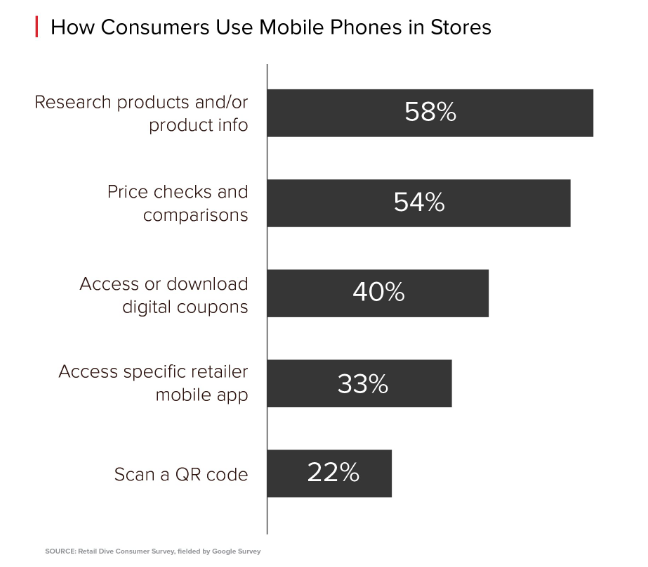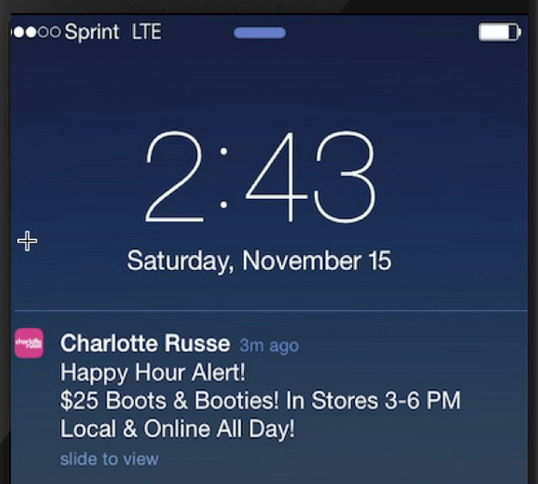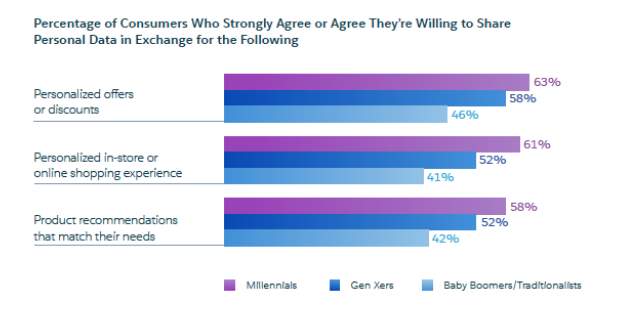With online shopping growing in popularity, retailers need to come up with new ways to keep their customers engaged to drive sales.
Retail stores are no longer just competing with other neighboring shops. Consumers can shop for virtually anything from the comfort of their own homes or even on the go from ecommerce shops.
If your retail business can’t adapt to new technology and the latest trends, you’ll struggle for survival in the coming years.
Beacon technology is definitely something your business should consider using. While the term may sound futuristic and complex, it’s actually quite simple.
You’ll be using beacons to track your customers, similarly to GPS. Although beacons and GPS are often confused and associated with each other, they’re not the same.
GPS technology needs three major components to work:
- satellites
- ground stations
- receivers
Receivers, such as a cell phone or a car, send signals to satellites that calculate the distance between each one. As a result, these calculations can pinpoint exactly where the receiver is located.
Beacons are far less complex.
These devices are small and not very expensive. They run on battery power.
Instead of broadcasting their locations to multiple satellites, beacons simply share their locations with devices capable of receiving their identities.
It’s easy to install beacons throughout your retail store locations. Implementing this technology in your retail shops will help you increase sales by personalizing the customer experience.
If you have never used beacon technology before, this is the perfect guide for you. I’ll show you how to leverage this technology to drive retail sales.
You’ll even learn how beacons can help generate revenue for ecommerce businesses without physical locations.
Encourage customers to download your mobile app
The first thing you need to do is get people to download your mobile application.
If your retail store doesn’t have an app, you’ll have to put your beacon technology strategy on hold until the app is built. Your app is a great way to increase sales by encouraging mobile spending.
I’ve spoken to many business owners who are hesitant to launch apps for their retail stores. They don’t think it’s necessary because their clientele would rather shop in person than online.
Sure, some people would rather see, touch, feel, and try on items in person as opposed to online, but the reality is they are still using mobile devices during the process.
In fact, 80% of people have used their mobile devices inside of physical stores to improve their shopping experiences.
This is how consumers are using their devices:

You need to make sure your mobile app has all of these functions.
If you think your app needs improvement, you should read my guide on the top successful features of a mobile commerce app.
People won’t want to download your app unless it improves their shopping experience. But if your app does all of the things on the list above, it will be easier for you to get more downloads.
But you can’t just assume your customers will download the app simply because it’s available.
You need to promote it on all your distribution channels.
Share a link to the app store on your website. Talk about it on social media. Include a download link in your email campaigns.
Give your customers an incentive to download it, such as a coupon or discount off their next purchases.
Once the app is installed on their mobile devices, you’ll be able to use beacons to drive sales.
Monitor customer movement in your stores
If you have beacons set up throughout your retail store, you can track the way users shop.
It’s simple. When a customer who has your app walks past a beacon, the beacon transmits a signal.
Here’s a visual representation of the way this works:

As you can see, the example above ends with the customer receiving a targeted, personalized message.
But you need to make sure there are specific parameters set up before a message gets sent. Here’s what I mean.
Let’s say your retail store sells clothing.
A male customer who has your mobile app on his smartphone comes in to buy a new pair of jeans. But in order to get to the men’s jeans section, he needs to walk past the baby clothes and footwear.
If you have beacons installed in those locations of the store that automatically trigger a message about those departments, it’s ineffective. In fact, this strategy will probably backfire.
We know that 52% of app users find push notifications annoying and distracting.
Further, 46% of people will disable push notifications if they receive more than two from the same app in one week. And 32% of users will stop using an app altogether if they get six or more notifications a week.
Make sure your message is relevant and timely, which I’ll discuss in greater detail shortly.
You can send the user a message if they are spending long periods of time near a certain beacon.
For instance, if that shopper in the above example is spending 15 minutes in the men’s jeans section, it’s a safe assumption they’re shopping for that product.
Improve in-store navigation
If you have a small boutique retail shop, your customers may not need much help getting around your store. The layout is probably pretty self-explanatory.
But that’s not the case for all retail locations.
Sometimes, it feels you can get lost inside these big shops. Customers spend more time trying to find their way around than they do shopping.
What’s your current system for helping customers navigate through the store?
Maybe you have a store map at the entrance or signs above each aisle.
But that doesn’t help someone who is in aisle 14 and the product they’re looking for is in aisle 26. They aren’t going to walk back to the entrance to read the map, and they certainly can’t read the signs that far away.
Traditionally, this is how retail shops operate. But now, with the help of technology, you can create a map function in the mobile app.
Take a look at how Target puts a creative twist on this simple feature:

Its customers can use this tool to create a shopping list before they arrive at the retail location.
When they arrive, the map will indicate where to find the items they need. This makes it easy for them to navigate around the store without getting lost.
Beacons placed throughout the store will show where the item is in relationship to the signal being transmitted from the phone.
Send timely discounts
As I said earlier, you want to make sure that any messages you send to your customers are timely and relevant.
For the most part, you can’t go wrong with sending a discount. Everyone wants to get a deal.
Think about the shopping experience from the perspective of your customers. As they browse around the store, they get a notification on their device.
Which type of message do you think would entice them to make a purchase?
“We sell winter coats and jackets!”
or
“20% off all winter coats and jackets!”
This is a rhetorical question. Obviously, the discount is more enticing.
Furthermore, discounts and coupons are the number one reason why shoppers would agree to in-store tracking and push notifications.

Stick to what you know your customers want. Don’t try to make things more complicated than they need to be.
If you send them a push notification or message that’s for something other than a discount, it’ll annoy them. Then you run the risk of that customer disabling their location settings or turning off push notifications for your app.
Target nearby customers
Customers don’t need to be in your retail store to benefit from your beacon technology campaigns.
You can use beacons to target customers who are in the area.
If you place beacons around stores, you can send a message to customers giving them a reason to come in and shop.
Take a look at this example from Charlotte Russe:

A customer who passes a beacon near the store could be sent this type of push notification.
Take a moment to look at the time this message was sent.
It’s reflects my previous point about timely discounts.
The in-store promotion is being run 3:00 PM – 6:00 PM. The push notification was sent at 2:40 PM to someone in the area.
You can use this strategy to run flash sales and other promotions as well.
It makes much more sense to send an in-store promotion to someone in the area than to every single app user. If people aren’t in the area, the promotion won’t be relevant to them.
Improve customer profiles
Everything I’ve talked about so far involves timing concurrent with shopper’s behavior. But you can leverage beacon technology for future actions as well.
Collect data on the ways customers shop in your store. Then use that information to improve their profiles.
Right now, you are probably using data such as online browsing behavior and purchase history to send personalized recommendations to your customers.
For example, if a customer browses for headphones online but doesn’t purchase them, you may send them a follow-up email the next day with a discount on headphones.
You can do the same using beacon technology.
Consumers are willing to share personal data if it improves their shopping experience:

As you can see from the data, younger generations are more comfortable with this type of technology than older generations.
That said, it’s more likely that a Millennial will install your retail app on their phone than a Baby Boomer, so you should be in the clear here.
Besides, in order for you to proceed with beacons, you’ll need to request location permission from users as they install your app on their devices. Otherwise, you’d be in violation of their privacy rights.
Customers who spend longer periods of time in certain sections of your retail store are obviously interested in those products.
Include that information in their customer profiles.
The next time they launch the app or shop online while signed into their profiles, recommend those types of products on their homepages.
Use beacons for your ecommerce shop
The majority of the discussed ideas in this post are relevant to physical retail stores.
Yes, there were some examples of how retail shopping behavior can improve online shopping experiences as well.
But beacon technology can also be used for ecommerce shops without physical stores. You just need to get a bit more creative.
For starters, you still need to encourage your customers to download your app for this strategy to work effectively.
Focus on it no matter what. Just look at the way mobile commerce is trending upward:

Then you can put beacons in locations related to what you’re selling. Here’s what I mean.
If you sell surfboards, kayaks, paddleboards, etc., you can put beacons by a beach. When a customer with your app goes to the beach, they’ll get a notification about those types of products.
If your ecommerce shop sells sports jerseys and other fan apparel, you can put beacons outside of various sports stadiums.
For example, if a customer walks by Fenway Park in Boston, they’ll get a notification about discounted Red Sox jerseys and hats.
This would make more sense than sending them a notification about a team that plays in Los Angeles.
The promotions are still timely and relevant, improving the user experience. This type of message would definitely entice the app user to buy from your ecommerce shop.
Conclusion
Retailers need to adapt to new technology trends if they want to survive today and in the future.
Beacon technology is a great place for your retail store to start.
First, you need to make sure as many customers as possible download your mobile app.
Then, you can place beacons throughout your store to monitor their shopping behavior.
Use this information to send them timely, relevant, and personalized messages that will improve their shopping experience and drive sales. Beacons can be used to target customers in the vicinity of your shop by enticing them to come in and buy something.
Once you collect data about customer in-store shopping behavior, you’ll be able to improve their customer profiles.
Ecommerce shops without physical stores can benefit from this technology as well. You just need to think outside the box to find places for your beacons.
If you follow the tips I’ve outlined above, your retail stores and ecommerce shops will generate more sales with the help of beacon technology.
How is your retail business using beacons to improve the customer experience?
from Quick Sprout https://ift.tt/2RBrEmy
No comments:
Post a Comment